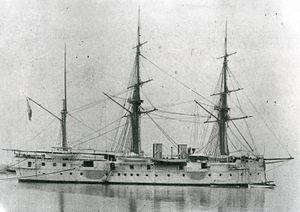Spanish cruiser Aragon
 Aragon
| |
| History | |
|---|---|
| Name | Aragon |
| Namesake | The Kingdom of Aragon |
| Ordered | January 1869 |
| Builder | Naval shipyard at Cartagena, Spain |
| Laid down | 2 May 1869 |
| Launched | 31 July 1879 |
| Completed | 1880 |
| Decommissioned | mid-1890s |
| Fate | Hulked 1896. Either sold for scrap 1900[1] or stricken c. 1905[2] |
| General characteristics | |
| Class and type | Aragon-class unprotected cruiser |
| Displacement | 3,289 tons |
| Length | 236 ft 0 in (71.93 m) |
| Beam | 44 ft 0 in (13.41 m) |
| Draft | 23 ft 6 in (7.16 m) maximum |
| Installed power | 1,400 ihp (1,000 kW) |
| Propulsion | 1-shaft, 3-cylinder, horizontal compound |
| Sail plan | barque-rigged |
| Speed | 14 knots (26 km/h; 16 mph) |
| Range | 1,660 nmi (3,070 km; 1,910 mi) |
| Complement | 392 officers and enlisted |
| Armament |
|
| Notes | 460 tons of coal (normal) |
Aragon was an Aragon-class unprotected cruiser of the Spanish Navy in the late 19th century.
Technical characteristics[edit]
Aragon was built at the naval shipyard at Cartagena, Spain. Her construction as an armored corvette with a central battery ironclad design began on 2 May 1869, with plans to give her 890 tons of armor and 500 millimetres (20 in) of armor at the waterline. Political events delayed her construction. In 1870, her design was changed to that of an unprotected cruiser or wooden corvette,[1][3] and she finally was launched in this form on 31 July 1879 and completed in 1880[1] Her original conception as an armored ship and the change to an unarmored one during construction left her with an overly heavy wooden hull that was obsolescent by the time of her launch.[4]
Designed for colonial service,[3] she had two funnels and was rigged as a barque.[4] Her machinery was manufactured by the John Penn Company of Greenwich, United Kingdom.[1] The original main battery of Armstrong-built 8-inch (203 mm) guns was obsolescent when she was completed, and were quickly replaced with more modern Hontoria-built 6.4-inch (163 mm) guns (a heavier main battery than that carried by her two sisters Castilla and Navarra), at least four of which were mounted in sponsons.[4]
Operational history[edit]
In the 1890s, Aragon was assigned to the Cadiz Naval Group. She went out of service in the mid-1890s and became a floating hulk in 1896. Sources differ on her ultimate fate; either she was sold for scrap in 1900[1] or stricken c. 1905[4]
Notes[edit]
References[edit]
- Chesneau, Roger, and Eugene M. Kolesnik, Eds. Conway's All The World's Fighting Ships 1860–1905. New York, New York: Mayflower Books Inc., 1979. ISBN 0-8317-0302-4.
- Nofi, Albert A. The Spanish–American War, 1898. Conshohocken, Pennsylvania:Combined Books, Inc., 1996. ISBN 0-938289-57-8.
